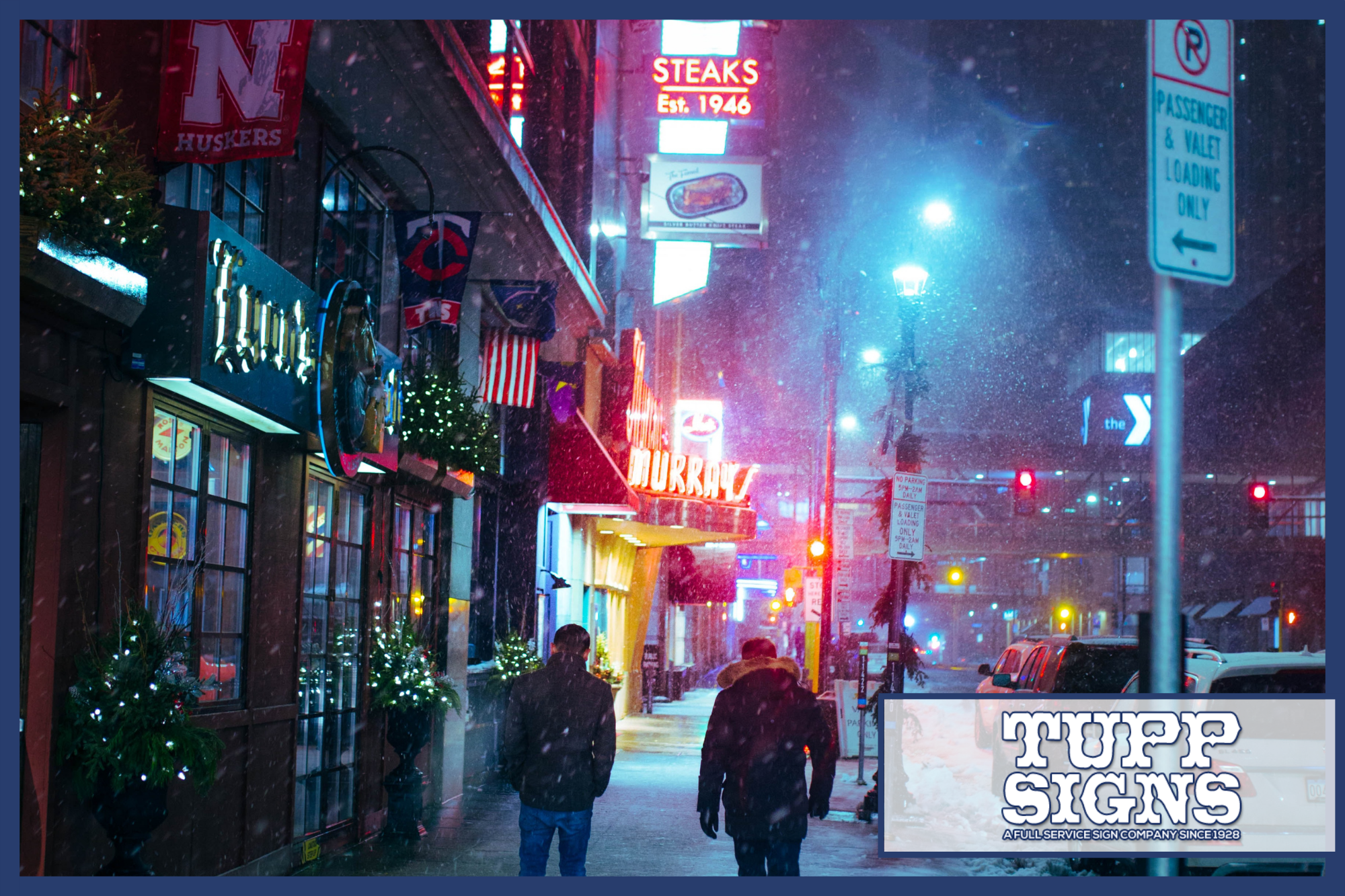True or false: outdoor signage is designed to weather extremely cold conditions. If you answered false, you are correct. Yes, most outdoor signage has been made with resilient materials, like aluminum, vinyl, and LED lights, to keep them operating throughout the year. However, winter is also a mixed bag of threats for your signage. Cold weather is by no means gentle, and the freezing and thawing of snow and ice can destroy your outdoor signs in a matter of days if you are not careful.
To help protect your outdoor signage, we have come up with some tips on how to prepare for winter. Let’s get started.
Wintry Conditions to Watch Out For
Depending on where you live, winter may be mild. For others, you could be dealing with a never-ending wall of sleet, snow, and wind. Most wintry conditions will have some effect on your signage, such as fog adding condensation to the inside of a lightbox.
The cold temperatures alone pose plenty of risks. Drops in temperature, as well as unseasonable warm days, are hazardous. Plastics, for example, will crack if temperatures go from freezing to warm too quickly. Other winter risks include ice. Any ice on the surface of a sign could scratch the materials, warp the materials, or peel off any paint.
Protecting Digital Signage
Does your outdoor signage include electronic message centers or LED displays? Though a digital sign has greater visibility and looks fantastic from far away, it is also more susceptible to weather than traditional static signs. Temperature fluctuations do terrible things to hardware. If you have electronic signs, do the following to ensure they stay functional this winter:
- Inspect the seals of the sign to make sure they are not coming apart. If you spot any parts that have come unsealed, get them repaired immediately. Otherwise, moisture could seep in.
- Keep in mind that LED lights work best between 59 degrees F and 77 degrees F. When temperatures drop below that in the winter, it will hinder performance. Ask your local sign company about heating solutions.
- Purchase weather-resistant housing for electronic signs. This includes tight seals, rust-resistant metals, heating, and ventilation.
- Mount your EMC or digital display securely.
- Use insulation for thermal regulation.
Check Out The Mount
Most types of signage are mounted to your building—channel letters, cabinet signs, and so on. That mount, however, can be the weakest link in the winter. Ice, snow, and frost can warp improperly installed structures. Any spaces may expand and crack during the freeze/thaw cycle. Even a blizzard’s wind could pull signs from their mounts.
Pay attention to the quality of installation, not just the location. Poles are highly durable and eliminate those tight spaces where snow and ice can get in. But regardless of where the sign is mounted, make sure the mount is made of something durable, like carbon steel.
Don’t forget to ground your signage to something sturdy, such as a cement wall. Be sure to check the integrity of the mount—whether it’s rickety or unyielding. Make sure the anchors aren’t rusting or cracked. Check to make sure the pole for your pylon sign isn’t shaking.
All these steps can help during windy winter days.
Stop Water From Building Up
When snow and ice starts melting, you need to do something about it. Water can be damaging to many materials. If snow and ice on your sign happens to leak into the sign itself (like a cabinet sign), the added weight could cause cracking; electrical components may also suffer.
The solution? Clean water away from depressions. Also, you may want to install the signage under an awning or somewhere snow and ice cannot build up. If you have freestanding signage, like a ground-level monument sign, one way to prevent water damage is to either build a trench or use well-draining soil.
Schedule Signage Maintenance
Even if your sign is guaranteed weather-resistant, you need to properly maintain the hardware. Hire a professional, since maintenance is often complicated and involves dissembling, cleaning, inspecting, and rebuilding the sign.
When you are in-between those scheduled maintenance visits, don’t forget to do some checks yourself. This will help keep your signage functional. Plus, if you catch any issues before they transform into a major problem, you save some time and money.
Typical wear and tear for outdoor signage includes things like broken lighting, burned out bulbs, cracks, discoloration, and grime. Wash your sign and replace lighting when you get the chance to maintain the overall condition. And don’t forget: replace old products that have outgrown their usefulness to keep your signs from looking shabby.
Conclusion
Wintertime is undoubtedly a time of mixed emotions. Business is probably booming, but all that wintry weather is going to be chipping away at your signs. Leaving your outdoor signage exposed to the elements may deduct from the lifespan. Mitigate the issues by scheduling routine maintenance throughout the year.
Need assistance with maintaining your business signage? Tupp Signs has been building, installing, and troubleshooting signs for many years. So, give us a call or fill out the contact form whenever you need help. We have the solutions.



